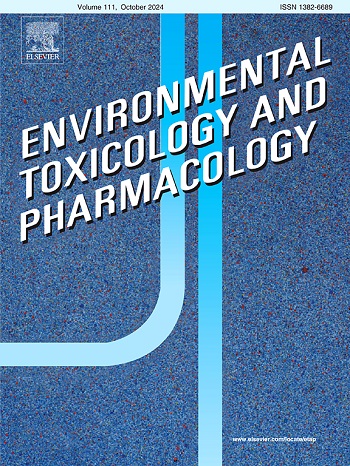Multi-disciplinary investigation identifies increased potency of ethyl-parathion inhaled within a soil-dust matrix to cause acetylcholinesterase-dependent molecular impacts
IF 4.2
3区 环境科学与生态学
Q2 ENVIRONMENTAL SCIENCES
引用次数: 0
Abstract
Neurotoxicity investigations of inhaled organophosphorus pesticide (OP), ethyl-parathion (EP), were conducted in Sprague Dawley rats comparing exposures to EP volatilized at 0, 1, 10, and 20 mg/m3 versus EP incorporated into soil dust (5 mg/m3) at 0, 0.0095, 0.09, and 0.185 mg/mg3. All exposures were sublethal, caused no respiratory effects, and no effects on balance and coordination behavior. Both volatilized and dust-incorporated EP exposures significantly decreased acetylcholinesterase (AChE) activity in plasma and hippocampus tissue. Correspondingly, plasma and hippocampal dopamine levels spiked in these exposures suggesting compensatory cholinergic / dopaminergic signal balancing. The EP exposures significantly increased expression of pro-inflammatory genes, including MAPK-14, IL6, IL1β, and TNF-α, while global RNA-seq results identified significant enrichment of inflammation, oxidative stress, and apoptosis pathways. Remarkably, dust-incorporated EP impacted similar molecular endpoints as volatilized EP but at concentrations two orders of magnitude lower highlighting potentially increased potency of EP incorporated into soil dust.
多学科研究发现在土壤-粉尘基质中吸入乙基对硫磷的效力增加,导致乙酰胆碱酯酶依赖的分子影响。
对吸入有机磷农药(OP)乙基对硫磷(EP)在Sprague Dawley大鼠中的神经毒性进行了研究,比较了0、1、10和20mg/m3挥发的EP与0、0.0095、0.09和0.185mg/ m3土壤粉尘(5mg/m3)中的EP的暴露情况。所有暴露都是亚致死的,没有引起呼吸作用,也没有影响平衡和协调行为。挥发性和粉尘性EP暴露均显著降低血浆和海马组织中的乙酰胆碱酯酶(AChE)活性。相应地,血浆和海马多巴胺水平在这些暴露中飙升,表明代偿胆碱能/多巴胺能信号平衡。EP暴露显著增加了促炎基因的表达,包括MAPK-14、il - 6、il -1 β和TNF-α,而全局RNA-seq结果发现炎症、氧化应激和凋亡途径显著富集。值得注意的是,与挥发性EP影响相似的分子端点,但浓度低两个数量级时,表明土壤粉尘中EP的潜在效力增加。
本文章由计算机程序翻译,如有差异,请以英文原文为准。
求助全文
约1分钟内获得全文
求助全文
来源期刊
CiteScore
7.00
自引率
4.70%
发文量
185
审稿时长
34 days
期刊介绍:
Environmental Toxicology and Pharmacology publishes the results of studies concerning toxic and pharmacological effects of (human and veterinary) drugs and of environmental contaminants in animals and man.
Areas of special interest are: molecular mechanisms of toxicity, biotransformation and toxicokinetics (including toxicokinetic modelling), molecular, biochemical and physiological mechanisms explaining differences in sensitivity between species and individuals, the characterisation of pathophysiological models and mechanisms involved in the development of effects and the identification of biological markers that can be used to study exposure and effects in man and animals.
In addition to full length papers, short communications, full-length reviews and mini-reviews, Environmental Toxicology and Pharmacology will publish in depth assessments of special problem areas. The latter publications may exceed the length of a full length paper three to fourfold. A basic requirement is that the assessments are made under the auspices of international groups of leading experts in the fields concerned. The information examined may either consist of data that were already published, or of new data that were obtained within the framework of collaborative research programmes. Provision is also made for the acceptance of minireviews on (classes of) compounds, toxicities or mechanisms, debating recent advances in rapidly developing fields that fall within the scope of the journal.

 求助内容:
求助内容: 应助结果提醒方式:
应助结果提醒方式:


